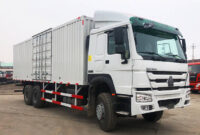2017 Semi Trucks For Sale: The Sweet Spot for Savvy Buyers pickup.truckstrend.com
The trucking industry is the backbone of commerce, and for owner-operators and fleet managers, the choice of equipment is paramount. While brand-new trucks offer the latest technology and warranties, their significant upfront cost and rapid depreciation can be daunting. On the other end of the spectrum, older models might be cheap but come with higher maintenance risks. This brings us to the unique and often overlooked sweet spot: 2017 Semi Trucks For Sale.
These vehicles represent a critical juncture in truck manufacturing, offering a compelling blend of modern features, proven reliability, and significant cost savings. A 2017 semi truck has typically depreciated past its steepest curve, yet it’s still recent enough to incorporate valuable advancements in fuel efficiency, driver comfort, and safety. For anyone looking to enter the trucking business, expand an existing fleet economically, or simply upgrade without breaking the bank, understanding the value proposition of a 2017 semi truck is essential. This comprehensive guide will delve into why these trucks are a smart investment, what to look for, and how to navigate the purchasing process effectively.
2017 Semi Trucks For Sale: The Sweet Spot for Savvy Buyers
Why Consider a 2017 Semi Truck? The Sweet Spot in Value and Performance
Purchasing a 2017 semi truck offers a multitude of advantages that make it an attractive option for a wide range of buyers:
- Optimal Depreciation Curve: New trucks lose a substantial portion of their value in the first few years. By 2017, these trucks have already absorbed the initial, steep depreciation hit, meaning you can acquire a well-maintained unit for significantly less than its original price. This allows for a much better return on investment over the truck’s remaining operational life.
- Modern Yet Proven Technology: The 2017 model year strikes an excellent balance. These trucks typically feature EPA 2010 emissions compliance (with refinements for GHG14/17 standards), which means they incorporate Diesel Particulate Filters (DPF) and Selective Catalytic Reduction (SCR) with Diesel Exhaust Fluid (DEF). While these systems require maintenance, they are well-understood by mechanics and parts are readily available. Crucially, 2017 models are universally ELD (Electronic Logging Device) compatible, essential for compliance with the mandate that took full effect in late 2017/early 2018. They also often include advanced aerodynamics, improved automated manual transmissions (AMTs), and enhanced driver comfort features that were becoming standard.
- Reliability and Longevity: By 2017, many manufacturers had refined their engine and chassis designs. A well-maintained 2017 truck, with typical mileage ranging from 500,000 to 800,000 miles, still has hundreds of thousands of miles of service life left, especially with proactive maintenance. Their components are robust and designed for long-haul durability.
- Cost-Effectiveness: Beyond the lower purchase price, 2017 models often come with lower insurance premiums compared to brand-new units. While fuel efficiency has continued to improve in newer models, the advancements in 2017 trucks still offer respectable MPG figures, making them economical to operate.
- Wider Selection and Availability: Being a few years old, the market for 2017 semi trucks is robust. There’s a wider variety of makes, models, configurations (sleeper, day cab), and specifications available from various dealerships, auctions, and private sellers, giving buyers more options to find the perfect fit for their needs.

Key Features and Technologies in 2017 Models
Understanding the typical features found in 2017 semi trucks helps buyers evaluate potential purchases:
- Engines: Common engines include the Detroit DD15, Cummins ISX (later X15), Volvo D13, PACCAR MX-13, and Mack MP8. These engines are known for their power, torque, and improving fuel efficiency. It’s crucial to check the specific engine model and its maintenance history, as some engines have known quirks or preferred service intervals.
- Transmissions: While manual transmissions were still popular, Automated Manual Transmissions (AMTs) like Eaton Fuller UltraShift, Volvo I-Shift, and Detroit DT12 were gaining significant traction. AMTs offer ease of driving, especially for new drivers, and can contribute to fuel savings by optimizing shift points.
- Aerodynamics: Manufacturers continued to refine truck aerodynamics in 2017 to reduce drag and improve fuel economy. This included redesigned hoods, cab extenders, fairings, and chassis skirts.
- Safety Features: Standard safety features included Anti-lock Braking Systems (ABS), Traction Control Systems (TCS), and often basic Electronic Stability Control (ESC). Some higher-trim models might have had early versions of collision mitigation or lane departure warning systems, though these were not as prevalent as in newer trucks.
- Driver Comfort: Interiors focused on ergonomics and comfort, particularly in sleeper cabs. Features like comfortable mattresses, ample storage, auxiliary power units (APUs) for climate control, and improved sound insulation were common, recognizing the long hours drivers spend on the road.
- Emissions Systems: All 2017 models adhere to EPA 2010 standards, utilizing DPFs to capture soot and SCR systems with DEF to reduce nitrogen oxides. Proper functioning of these systems is vital for compliance and avoiding costly repairs.


Types of 2017 Semi Trucks Available
The market offers a diverse range of 2017 models to suit various hauling needs:
- Freightliner Cascadia: Often the most common truck on the road, known for its aerodynamics, widespread parts availability, and robust Detroit Diesel engines. A solid all-around choice.
- Kenworth T680 / Peterbilt 579: These PACCAR siblings are popular for their premium feel, driver comfort, and fuel efficiency, often powered by the PACCAR MX-13 engine. The Peterbilt 389, with its classic long-hood styling, was also available, albeit in smaller numbers.
- Volvo VNL: Renowned for its safety features, comfortable and quiet cabs, and integrated Volvo powertrain (Volvo D13 engine and I-Shift transmission).
- Mack Pinnacle / Anthem: Mack trucks are known for their durability and strong pulling power, especially with the Mack MP8 engine. The Anthem, a newer aerodynamic model, was introduced around this time.
- International ProStar / Lonestar: International offers a range of trucks known for their driver-friendly designs and various engine options, including Cummins ISX.
Buyers can find these models in both sleeper configurations (for long-haul over-the-road applications) and day cab configurations (for local, regional, or vocational work where the driver returns home daily). The choice depends entirely on the intended use and operational requirements.
What to Look For When Buying a 2017 Semi Truck: A Buyer’s Checklist
Purchasing a used semi truck requires meticulous inspection and due diligence. Follow this checklist to ensure a sound investment:
- Maintenance Records are Gold: Request a complete maintenance history from the seller. Look for regular oil changes, filter replacements, DPF cleaning/bake cycles, and any major component replacements (e.g., turbocharger, injectors, transmission work). A gap in records is a red flag.
- Mileage and Engine Hours: While mileage is a key indicator, engine hours can also be crucial, especially for trucks that idle frequently. Look for a reasonable ratio (e.g., 50-60 mph equivalent per hour).
- Professional Pre-Purchase Inspection (PPI): This is non-negotiable. Hire an independent, trusted heavy-duty mechanic to perform a thorough inspection, including engine diagnostics (checking fault codes, fuel pressure, oil pressure), chassis, suspension, brakes, tires, and emissions systems.
- Tires and Brakes: These are significant wear items. Check tire tread depth evenly across all tires, and inspect brake pads, drums/rotors for wear. Replacing these can be a substantial upfront cost.
- Fluid Leaks: Inspect around the engine, transmission, differentials, and cooling system for any signs of leaks.
- Frame and Suspension: Look for cracks, excessive rust, or previous repair welds on the frame rails. Check kingpins, bushings, airbags, and leaf springs for wear or damage.
- Emissions System Health: The DPF and SCR systems are critical and costly to repair. Ensure there are no active fault codes related to these systems. Inquire about DPF cleaning history and DEF consumption rates.
- Interior Condition: Assess the cab’s overall condition, including the seats, dashboard, gauges, HVAC system, and sleeper amenities. A well-maintained interior often indicates a driver who cared for the truck.
- Test Drive: Take the truck for an extended test drive. Listen for unusual engine noises, check for smooth shifting (especially with AMTs), evaluate steering response, and ensure all lights and accessories function correctly. Pay attention to how the truck handles on different road conditions.
Financing Your 2017 Semi Truck Purchase
Securing financing for a used semi truck can be different from financing a car. Here’s what to consider:
- Specialized Lenders: While traditional banks offer financing, specialized truck financing companies are often more familiar with the industry’s unique challenges and offer more flexible terms.
- Credit Score and Down Payment: A strong credit score will secure better interest rates. Be prepared for a down payment, typically ranging from 10% to 25% of the purchase price.
- Business Plan: If you’re a new owner-operator, having a solid business plan outlining your projected income, expenses, and a clear understanding of the trucking market will strengthen your loan application.
- Loan Terms: Understand the interest rate (fixed vs. variable), loan term, and any prepayment penalties.
Tips for a Successful Purchase and Operation
- Set a Realistic Budget: Factor in not just the purchase price, but also sales tax, registration, insurance, initial maintenance (fluids, filters), and potential unexpected repairs.
- Don’t Rush: The right truck will come along. Be patient and thorough in your search and inspection process.
- Negotiate: Always negotiate the price. Research similar trucks to understand the market value.
- Consider Extended Warranties: Some third-party companies offer extended warranties for major components (engine, transmission, differentials) on used trucks. Evaluate if the cost justifies the potential protection.
- Proactive Maintenance is Key: Once purchased, adhere strictly to the manufacturer’s recommended maintenance schedule. Regular preventative maintenance will extend the life of your 2017 semi truck and minimize costly breakdowns.
- Understand Total Cost of Ownership (TCO): Calculate not just the purchase price, but also fuel, maintenance, insurance, financing, and depreciation over the truck’s lifespan.
Potential Challenges and Solutions
Even a well-chosen 2017 semi truck can present challenges:
- High Mileage: While common, very high mileage (e.g., 900,000+ miles) increases the risk of major component failure. Solution: Focus on trucks with excellent, documented maintenance histories, and prioritize those that have had significant overhauls or component replacements. A thorough PPI is even more critical here.
- Emissions System Issues: DPF and DEF systems can be temperamental and costly to repair. Solution: Ensure the truck passes a diagnostic scan with no active emission-related fault codes. Inquire about DPF cleaning frequency and ensure the DEF system is working correctly. Budget for potential DPF cleaning or sensor replacements down the line.
- Hidden Mechanical Problems: Not all issues are apparent during a visual inspection. Solution: The independent pre-purchase inspection is your best defense. A reputable mechanic can identify potential problems that an untrained eye might miss.
- Financing Difficulties: New owner-operators or those with lower credit scores might struggle to secure favorable loan terms. Solution: Save for a larger down payment, explore various lenders, or consider working for a company that offers lease-purchase programs (though these often have their own drawbacks).
2017 Semi Trucks For Sale: Estimated Price Guide
Please note that these are estimated ranges. Actual prices vary significantly based on specific make/model, engine, transmission, mileage, condition, maintenance history, geographical location, and current market demand. This table provides a general overview for well-maintained used trucks.
| Manufacturer/Model | Typical Mileage Range | Engine Type (Common) | Sleeper/Day Cab | Condition (Used) | Price Range (USD) | Key Features (Examples) |
|---|---|---|---|---|---|---|
| Freightliner Cascadia | 500,000 – 800,000 | Detroit DD15, Cummins X15 | Sleeper | Good – Excellent | $35,000 – $65,000 | Aerodynamic, spacious interior, common parts, excellent MPG |
| Kenworth T680 | 450,000 – 750,000 | PACCAR MX-13, Cummins X15 | Sleeper | Good – Excellent | $40,000 – $70,000 | Driver comfort, premium feel, strong resale value, fuel-efficient |
| Peterbilt 579 | 450,000 – 750,000 | PACCAR MX-13, Cummins X15 | Sleeper | Good – Excellent | $40,000 – $70,000 | Premium interior, classic styling, robust build, high demand |
| Volvo VNL | 550,000 – 850,000 | Volvo D13 | Sleeper | Good – Excellent | $30,000 – $60,000 | Safety features, integrated powertrain, comfortable, quiet cab |
| International ProStar | 550,000 – 850,000 | Cummins X15, MaxxForce | Sleeper | Fair – Good | $25,000 – $55,000 | Good value, various engine options, driver-centric design, often lower entry cost |
| Mack Pinnacle / Anthem | 500,000 – 800,000 | Mack MP8 | Sleeper | Good – Excellent | $35,000 – $65,000 | Durability, strong pulling power, vocational versatility, robust drivetrain |
| Day Cab Models (All Brands) | 400,000 – 700,000 | Various | Day Cab | Good – Excellent | $25,000 – $50,000 | Lighter, maneuverable, ideal for local/regional hauls, lower operating cost |
Disclaimer: Prices are estimates and can vary significantly based on location, specific condition, maintenance history, exact specifications, and market demand.
Frequently Asked Questions (FAQ) about 2017 Semi Trucks For Sale
Q: Why choose a 2017 model over newer or older trucks?
A: 2017 models offer an excellent balance of value, modern features, and proven reliability. They’ve absorbed the steepest depreciation, are ELD-compliant, and feature refined emissions systems and driver amenities that older trucks lack, without the premium price tag of brand-new units.
Q: What are the common mileage ranges for 2017 trucks?
A: Most 2017 semi trucks for sale will have mileage ranging from 500,000 to 800,000 miles. Some may be lower if they were used regionally, or higher if they were dedicated long-haul trucks.
Q: Are 2017 trucks compliant with current ELD mandates?
A: Yes, all 2017 model year trucks are fully compatible with Electronic Logging Devices (ELDs), which became mandatory for most commercial drivers in the U.S. by December 2017.
Q: What should I look for in the maintenance records?
A: Look for consistent, documented preventative maintenance (oil changes, filter replacements), records of DPF cleanings/bake cycles, major component replacements (e.g., turbo, injectors, clutch, transmission work), and any recurring issues or repairs.
Q: How do I finance a used semi truck?
A: You can seek financing from traditional banks, specialized truck financing companies, or some dealerships. Be prepared for a down payment (10-25%) and have a solid credit history and/or business plan.
Q: What are the typical operating costs for a 2017 semi?
A: Operating costs include fuel, insurance, maintenance (preventative and reactive), tires, tolls, and financing payments. While fuel efficiency varies, 2017 models are generally efficient. Maintenance costs can be lower than older trucks but higher than new ones, as components begin to show wear.
Q: Are parts readily available for 2017 models?
A: Yes, parts for 2017 models are widely available, both new and aftermarket, from dealerships, truck stops, and parts suppliers. This is a significant advantage over much older or very new and niche models.
Q: What’s the difference between a DPF and DEF system?
A: A Diesel Particulate Filter (DPF) captures soot from the exhaust. A Selective Catalytic Reduction (SCR) system uses Diesel Exhaust Fluid (DEF) to convert harmful nitrogen oxides (NOx) into harmless nitrogen and water vapor. Both are part of modern emissions control.
Q: Should I get an extended warranty?
A: It depends on the truck’s condition, mileage, and your risk tolerance. An extended warranty can provide peace of mind for major component failures, but carefully review the coverage, deductibles, and exclusions to ensure it’s a worthwhile investment.
Conclusion
The market for 2017 semi trucks for sale offers an incredible opportunity for owner-operators and fleet managers seeking a balance between affordability and modern functionality. These trucks have moved past their initial depreciation, yet retain the reliability and features necessary for today’s demanding trucking environment. By conducting thorough research, performing meticulous inspections, and understanding the financial landscape, buyers can confidently acquire a robust, cost-effective asset that will serve their business well for years to come. Investing in a 2017 semi truck is not just buying a vehicle; it’s making a strategic decision for sustainable and profitable operation in the dynamic world of trucking.



